Fur Elise Piano Tutorial
 Are you looking for a Fur Elise Piano Tutorial?
Are you looking for a Fur Elise Piano Tutorial?
Would you like some strategies to tackle this much beloved Beethoven classic?
You’re in the right place.
In this lesson, you will learn the best ways to play Fur Elise.
Moreover, this Fur Elise piano tutorial will help you learn some neat vocabulary you can use to learn and play other tunes as well.
Let’s get started.
Why You Should Learn Fur Elise
 Now, why do I recommend learning Fur Elise?
Now, why do I recommend learning Fur Elise?
Personally, I think that Fur Elise is one of those classic pieces that is great as an etude.
Fur Elise is actually Ludwig Van Beethoven’s famous Bagatelle No. 25 in A Minor.
A bagatelle is a kind of short, light, and unpretentious piece of music.
Generally speaking, we approach playing Fur Elise as such.
However, I think of Fur Elise as an etude.
An etude is the kind of piano piece written specifically to develop piano technique.
While Fur Elise doesn’t appear to be intended as such, it has a lot of qualities that serve the purpose:
- You can learn how to use chord tones melodically and effectively.
- It teaches you how to use diatonic (i.e. scale) and chromatic notes to connect phrases and ideas.
- You’ll develop various left hand comping techniques.
- You’ll appreciate and understand fundamental chord progressions and harmony, especially tonic-dominant relationships.
All in all, Fur Elise helps you become a better pianist by helping you understand how music works. By understanding how music works, you can learn music faster, write your own music, and enjoy playing a lot more.
Let’s take a look at how we’re going to approach Fur Elise.
3 Big Segments You’ll Learn In This Fur Elise Piano Tutorial
While most piano tutorials only teach the relatively easy and famous bit, this lesson will teach you all the main ideas.
This includes the lesser known but more astonishing parts.
The first big segment will work on is the most famous one. We’ll call this the A section:
The B section is bright sounding and features awe inspiring runs:
The C section is a heavy, powerful, and climactic portion that leads all the way back to the main theme:
Now let’s get into the thick of it.
How To Play The A Section
The theme starts with this familiar opening passage:
- Assume a 5-finger position over A.
- Play E and D# with your 5th and 4th fingers.
- Play the rest of the passage as shown in the sheet music.
Next, we have to learn these two hand shapes (A2):
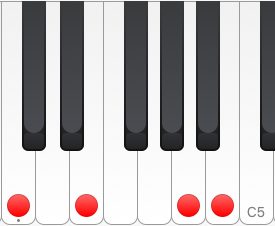
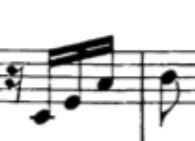
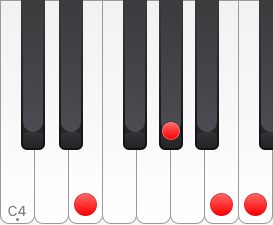
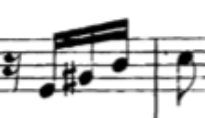
These two hand shapes above forms the melody of the next portion. All you have to do is arpeggiate these two hand shapes to play the melody:
If you look at the 2 hand shapes closely, you have a 1st inversion Am chord resolving to the B of the E chord. After that, you have a root position E major chord that resolves to the C of Am.
Next, repeat all of the bars you’ve just learned except for the last one which is simply an arpeggiated A(add9) chord in the 2nd inversion:
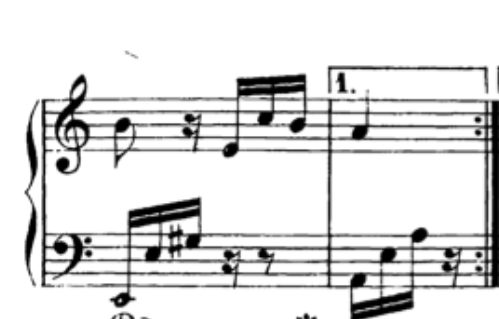
The left hand parts are quite simple:

- A-E-A or a root-5th-octave arpeggio pattern. This is an easy, simple and useful left hand pattern that can be used over any chord. In this case we use this as part of an Am chord.
- E-E(octave)-G# or a root-octave-3rd pattern. In this case, we use our major 3rd (G#). The B on the right hand completes the E major triad with this left hand part.
After this, let’s learn the next portion.
Here’s the chart:

The right hand is as follows:
- Opening goes B-C-D-E.
- 3 short ideas that go root-7th-6th-5th starting on G, F, then E.
 As you can see, the root-7th-6th-5th ideas outline 7th chords without 3rds. Interestingly, the last notes of these melodic lines form chords with the left hand parts.
As you can see, the root-7th-6th-5th ideas outline 7th chords without 3rds. Interestingly, the last notes of these melodic lines form chords with the left hand parts.
The left hand parts go like this:
- C-G-C: forms C major with the E of the right hand.
- G2-G3-B: forms G major with the D of the right hand.
- A-E-A: forms A minor with the C of the right hand.
This entire portion now ends with our sequence of E’s and then goes back to the first main idea:

 After learning all of these moves, all you have to do now in this Fur Elise piano tutorial is to check where the repeats are and play accordingly.
After learning all of these moves, all you have to do now in this Fur Elise piano tutorial is to check where the repeats are and play accordingly.
This is how you complete the most popular portion of Fur Elise.
You can always review the video of the A section above to hear how it sounds like and give you an idea how to perform it.
However, as we said earlier, there’s more to it.
Let’s start learning the B section.
How To Change Keys And Play The B Section
Just before entering the B section, we have this interesting V-I progression:
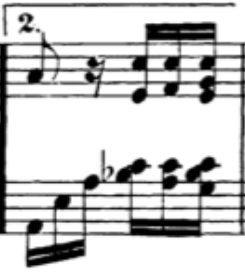
This is just a sophisticated way of alternating between C7 and F before landing on F to the B section.
The B section features a left hand part that’s called Alberti bass:

This particular Alberti bass pattern follows a I-IV-V chord progression in F. So we have F, B, and Csus4-C7 comping going on.
Let’s take a look at the right hand parts.
You start the passage by rolling an F major triad and then playing a very straightforward scalar melody:
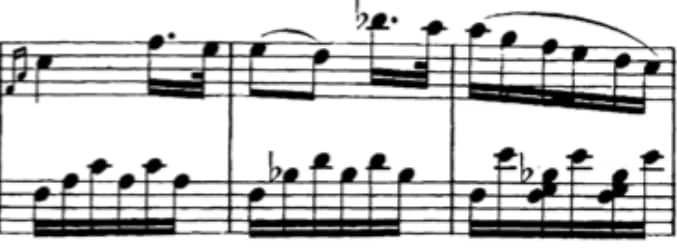
Next, we go to this chord progression: F – Am/E – Dm – G6 – G7. This chord progression is cleverly broken up in this bass line:

The right hand melody starts with a turn (A-G-A-Bb-C) then a chromatic passage leading to E.
Continue along the melody until you land on this fancy sounding run here:
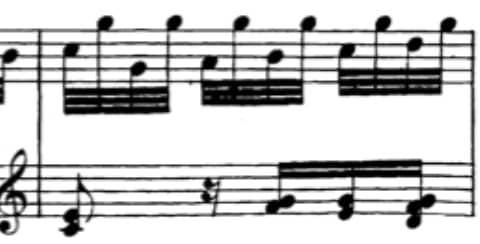

As you can see above, we have a tremolo passage at the start. The key to playing this fast tremolo motion is wrist movement.
The rest of the passage involves some scalar movement and then a move back to the A section.
After playing the A section, you will now move to the C section.
Let’s talk about the C section next.
Fur Elise Piano Tutorial Reveals How To Use Tension And Release
The big thing in section C for this Fur Elise piano tutorial is the use of secondary dominants:
The start of the C section is a pulsating bass line that uses A as a pedal tone almost all throughout.
Your right hand will pretty much do the work in terms of chord changes while keeping that A pedal tone with the left hand.
We simply start with an A then move to an Edim7 chord. This Edim7 chord with the right hand actually forms an A7(b9) chord when combined with the A bass line:


While keeping that left hand pedal tone, you play a right hand 1st inversion Dm followed by thirds (C#-E and D-F) then a rootless E7(b9) (G#-D-F) then resolve to a basic Am triad:
 After that, you change your bassline to D-A for the left hand while you play a descending line in 6ths for the right hand:
After that, you change your bassline to D-A for the left hand while you play a descending line in 6ths for the right hand:
Next, land on C-F#-A for the right hand while playing Eb-A on the left. This creates an Ebdim chord.
This will then resolve to a 2nd inversion Am by shifting to E-A for the left hand then the melody line C-A and E-C for the right hand.
Next, by keeping E-A for the left hand and playing D-B with the right, you now have an E7sus4 chord that will then resolve to Am on the next bar:

Next, you’re going to repeat the first 4 bars then land on a Bb major triad on the next bar with the right hand, shifting the pedal tone of the left hand to Bb as well. After that, play a descending 6ths line (G-Eb, F-D, Eb-C) with the right hand.

You will end up with a 1st inversion Bb triad then shift to a Dm triad on the 3rd beat. Since you’re still playing Bb on the Bass, this creates a Bbmaj7 chord together with the right hand.
Next, transition to a rootless E7(b9) chord by playing B natural on the bass and then D-F-G# on the right hand. This allows you to resolve to a 1st inversion Am chord for 1 bar, then an E major chord the next.
Lastly, play this triplet passage starting with an Am arpeggio flourish and then proceed to a descending chromatic line starting on E at the top register. This chromatic run will land you back on the A section of Fur Elise:

After playing that last portion of the C section, you will land back and repeat the A section to cap it off.
Final Words
 By learning the A, B, and C sections in this Fur Elise piano tutorial and then putting them together, you’ll be able to play this beloved Beethoven classic.
By learning the A, B, and C sections in this Fur Elise piano tutorial and then putting them together, you’ll be able to play this beloved Beethoven classic.
All that you have to do next is learn the repeats and use proper dynamics and expression.
I hope you enjoyed this lesson. If you have any comments, questions, or suggestions for a new lesson, feel free to leave a note below.
Have fun practicing!
